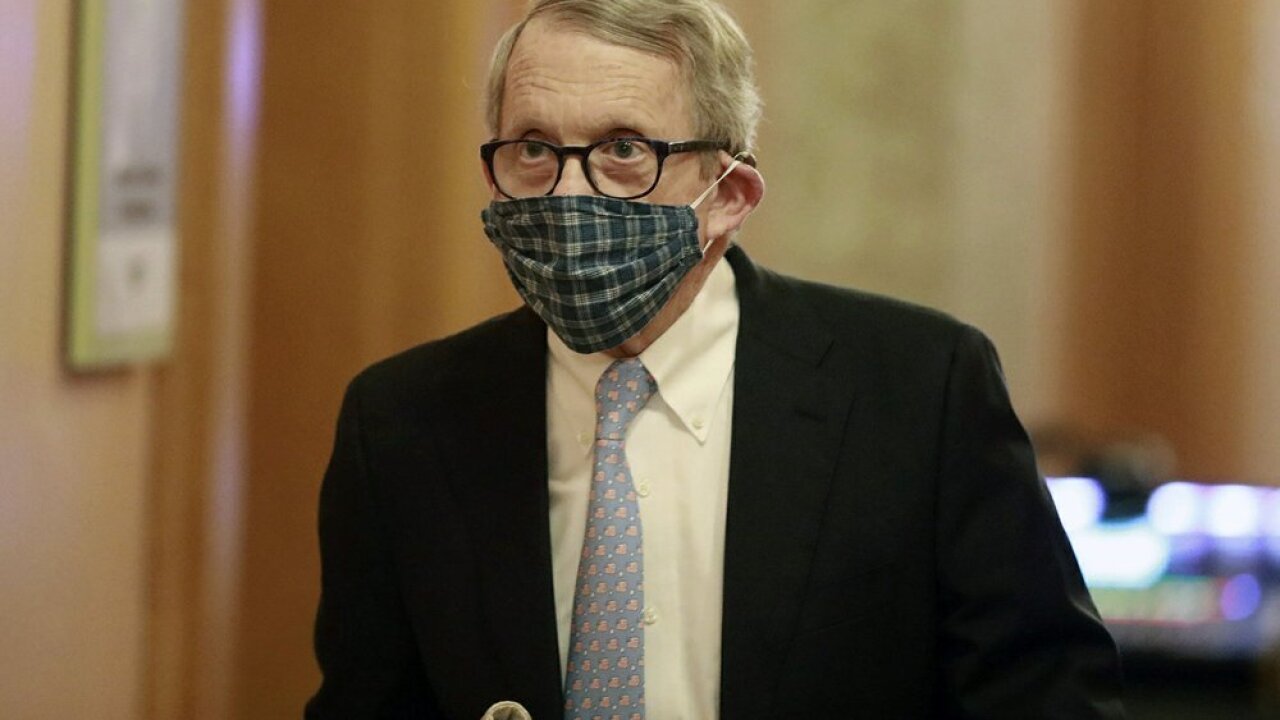COLUMBUS, Ohio — Ohio Gov. Mike DeWine on Wednesday unveiled a wide-ranging slate of police reform proposals for his state, including requiring all would-be police officers to undergo a psychological screening, establishing a statewide database tracking use-of-force incidents and mandating independent — not internal — investigations into all police shootings.
“These are things that have been talked about for a long, long time,” he said. “These are things that have been out there — I’ve talked about them, people have talked about them, the (Ohio Legislative) Black Caucus has talked about them, people in law enforcement have talked about them.
“It’s time for us to do it. It’s time for us to get these things done. There is no reason why these issues should not be dealt with.”
The proposals carry no weight of law — instead, they are recommendations from DeWine and Ohio Attorney General Dave Yost to the state legislature. Still, they represent a push toward greater police accountability in Ohio during a nationwide moment of reckoning.
The anti-police-brutality protests sparked by the police killing of George Floyd, a black Minneapolis man accused of using a counterfeit $20 at a deli, gathered force through late May and early June as they produced their own moments of viral outrage. Police in Kansas City pepper-sprayed Black Lives Matter protesters in a widely circulated video clip; police in Buffalo, New York, pushed a 75-year-old protester to the ground and fractured his skull, according to his lawyer.
The Black Lives Matter movement, founded in calls to end racial bias in policing, went mainstream in a way it hadn’t for years. Some activists across the country, including in Cincinnati, have begun to push for a top-down revision of what law enforcement looks like in the United States.
DeWine had rejected the prospect of “defunding” Ohio police departments the week before. The proposals he presented would, in fact, result in the state spending more money on police: More training for officers, more oversight for the state, more body cameras to monitor interactions between officers and the public. All, he said, would focus on enhancing departments’ accountability, training and transparency.
The full list of proposals includes:
- Establishing a psychological screening process for would-be police officers that would identify and disqualify candidates with racial bias.
- Offering six free hours of conflict deescalation training, including a focus on use of force and implicit bias, for any officer in the state.
- Asking the Ohio General Assembly to identify a funding stream that will support in-depth, up-to-date training for all officers every year.
- Reclassifying chokeholds as deadly force.
- Ensuring that all use-of-force incidents and deadly shootings are investigated by independent entities such as the Ohio Bureau of Criminal Investigation, not by members of the police department under investigation. (“Simply put, law enforcement agencies should not be investigating themselves. Even if they do a great job, there is an appearance of impropriety.”)
- Keeping a statewide database of police use-of-force incidents and allowing the public to view it.
- Creating a procedure to have Ohio law enforcement officers stripped of their law enforcement certification if they violate a set of professional conduct standards.
DeWine spent much of the conference on the last proposal, which he said would bring policing in line with other licensed professions.
Under existing Ohio law, a police officer can only lose their law enforcement certification if they are convicted of a felony. Officers who are convicted of lesser crimes or find themselves at the center of public controversies that do not result in a conviction — such as Timothy Loehmann, who shot and killed 12-year-old Tamir Rice in Cleveland — may lose their jobs but find other law enforcement work in other cities. (Loehmann was hired part-time by the Bellaire, Ohio, Police Department but quickly quit under public pressure.)
“We must begin treating our law enforcement officers like we treat those in other professions,” DeWine said. “Doctors, dentists, lawyers, barbers — those and many other occupations are held to high professional standards, often with a code of ethics. They report to oversight boards, and if they don’t follow the established professional standards, those licenses can be suspended or their license can be revoked.”
The proposed process would be overseen by a Law Enforcement Oversight and Accountability Board comprising law enforcement professionals as well as members of the public.
DeWine provided few specifics, including how much the various proposals might cost, but encouraged the state legislature to begin hearings “immediately.”
Yost, who spoke after DeWine, encouraged Ohio police officers to see the new regulations as an opportunity to increase the legitimacy of their work and build trust with the public.
“Those bad cops, and you know who they are, they are making your job and your mission harder,” he said. “Those few bad cops are putting your life in jeopardy. They’re making you less safe on the street. They’re why you’re being painted with the same broad brush.”
Despite DeWine repeatedly mentioning the Ohio Legislative Black Caucus and claiming the reforms he introduced were based on their recommendations, House Minority Leader Emilia Strong Sykes later wrote in a statement that they had only been consulted hours before the conference.
“These are not the recommendations of Black lawmakers—far from it,” she wrote. “What we want is to uplift the voices of Black Ohioans who we have heard from at protests, community meetings, and in everyday interactions. Statehouse Republicans, from the governor to the speaker, don’t seem interested in truly listening to Black Ohioans. They think they have the answers to hundreds of years of racism, brutality and oppression. They do not.”
Sykes said police reform is only one element of the change necessary to create a more equitable Ohio for black residents. Prominent among the others she listed: Passing a bill to declare racism a public health crisis.


